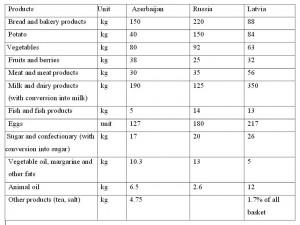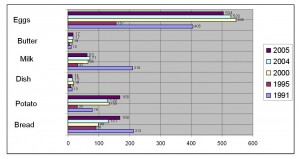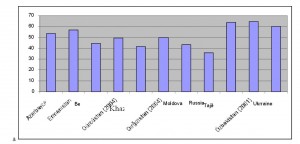Lately, there is a certain word that influences the life of all people and we sound several times a day: Inflation. It diffused into the life of everyone, from ordinary citizens to the entrepreneurs, from the unemployed to high-ranking officials. Now everyone “comes to agreement” with it about the activities for tomorrow. In such an “agreement” environment, putting aside the fact that the inflation is “at the necessary level” as the officials put it or according to the international and local experts’ assessments, it is “at the level that already causes disturbance”, we would like
to touch upon a range of important points that emerge under the circumstances of its existence and carry social responsibility burden.
At present, not only the economists, but also the ordinary citizens who perceive the impact of inflation in their life, have no doubts in the existence of the linkage between inflation level and living standards of the population. One of the objectives, the solution of which is pivotal for reducing the negative effect of this relationship, is not to allow the inflation “to devour” the incomes of the population, or in other words; one of the objectives is to protect real incomes of the population. This relationship is used to evaluate the impact of the price increase on the consumption, since the inflation influences the quantity of the goods the population could buy in exchange of the money they have “in hand”. Putting it simple, preventing the limiting of the incomes of the population by price increase is considered as “minimum obligation” of the government to protect the living standards. In general, in most world countries, the life value index is used to assess the living standards of the population.
Life Value Index is the ratio of the values of the products that serve to maintain the living standards at the identified level for two compared periods, as the ratio of the values of the products necessary for the surviving of human being in current and the compared base year is considered as the important indicator that characterizes the importance of maintaining the living standards in contrary to real incomes of the population. We should note this index was one of
first steps to estimate Consumer Prices Index (CPI). Unfortunately, in the republic, this indicator is not calculated. In addition, we cannot even deny the problems regarding the calculation of the minimum of subsistence. Before grouping the problems, we should note that they started emerging from the preliminary stage – ratification of legislation base, since as the result of the “suspension” of The Law of the Republic of Azerbaijan on “Minimum consumption budget” for a period over ten years, the application of such a norm as minimum consumption basket considered as a very important living standard was impossible due to the problems that arouse in passing new law.
Although The Law of the Republic of Azerbaijan on “The Minimum of subsistence” passed in 2004 laid the foundation of the “support point” in accepting the minimum standards, some problems remain as is mentioned above. What are these problems?
First problem deals with the norm of the products included in the minimum consumption basket. The following table enables us to compare the composition of the minimum consumption basket in several countries.
Table 1. Composition of the minimal consumption basket

As is seen, the norm of such important components as meat and meat products, milk and dairy
products, fish in Azerbaijan is at the lowest level.
Second problem is related with the prices used in estimating the minimum of subsistence, since
during the calculation, the standard “official prices” – prices “observed” by State Statistical
Committee – are applied. As a range of researchers claim, certain objective and subjective factors
lead to the indication of lower prices instead of the real prices. Consequently, the value of the minimum of subsistence decreases artificially. Here we should mention that within the frame of the project entitled “Working out alternative
inflation methodology” implemented with the support of USAID, Economic Researches Center has been conducting the price observations in a variety of regions in Azerbaijan for four months.
The result, obtained after calculating the minimum of subsistence based on the results gained during alternative price observations and using the norms approved by the legislation, was 30-40 per cent more than the officially announced value of the minimum of subsistence – 64 AZN, depending on the regions. By the way, at present, one of the main issues that should be focused on deals with the purchasing power, since the purchasing power of real incomes of the population allows us to
make certain judgment upon the changes in living standards.
Purchasing power of per capita incomes in Azerbaijan in various years

Source: Annual bulletin of Statistical Committee of CIS. 2006
As is seen from the Chart, the purchasing power of the population underwent fair degree of
changes during the course of certain years. This change shows that along with dynamic increase
of nominal incomes of the population, the prices of bakery and dairy products have gone up
sufficiently.
We should note that separate calculation of the minimum of subsistence on socio-demographic
groups and regions is desirable. It is also important for working out the actions on maintaining
the living standards of the population on each group, because at present, though the minimum of
subsistence is calculated for the children, the employed population and pensioners in Azerbaijan,
the regional division is not applied.
During the period when the inflation occurs, another important action in preserving living
standards is the indexing of the incomes of the population. As is mentioned above, preserving the
living standards at least at the current level requires again at least the coordination of current
incomes of the population with inflation level. Though the relevant legislative basis on this
direction was founded, its implementation is not started yet.
At present, preventing negative effect of the inflation to the living standard of the population
increases the importance of the following, along with the above-mentioned. First, we should
mention the theory and international expertise show that price change has a very strong impact
on the consumption of the population. In that case, it is necessary to review the consumption
structure of the population in the republic. Only based on this fact, we can define more exactly
the structure of the minimum of subsistence. However, we should note that as the typical
tendency distinguishing Post-Soviet countries, the rich stratum of the population refuses to
participate in the budget examination of the households in Azerbaijan as well. Consequently, the
goods and services, the prices of which often change and are high, are not the components of the
consumption basket or their share in the consumption basket is small. This leads to the
inaccuracies in estimating the minimum of living standards.
We think it is also important to review the poverty evaluation methodology. According to the
recommendations of the World Bank, in all developing countries, the poverty is assessed based
on the consumption. There is a need to apply this practice in Azerbaijan as well. Otherwise,
against the background of the price increase, the poverty evaluation without reviewing the
production structure may lead to inadequate results, or in other words, to the drastic decrease of
the figures on the poverty level.
We should also note one point that the assessment of the share of food in consumption
expenditure of the population is very pivotal for poverty evaluation, as at the end of last century,
rather, in the last 25 years, the application of Orshansky method in assessing the living standards
of the population started to expand. According to that methodology, if the household spends
more than 30 per cent of its aggregate consumption to buy food products (later that figure was changed to 25 per cent), then it is considered as a poor household. In general, the increase in the
share of the food in the consumption all over the world is considered as the indication of the
decrease in the living standards of the household. In the table below, the share of food
expenditure of in aggregate consumption of the households in Azerbaijan is compared with that
of a range of CIS countries in 2005.
Table 2. The share of food expenditure in aggregate expenditure households in CIS countries

Source: Annual bulletin of Statistical Committee of CIS, 2006
As we know, a significant increase of Gross Domestic Product was observed during recent years,
it experienced double increase in GDP per capita. However, according to the official statistical
data, the fact that the median incomes of the population are almost constant (within 50-54 AZN)
testifies the unequal income distribution. Of course, given the impact of inflation on these
incomes, we can definitely tell that there are still problems in this direction.
The existence of the inflation also requires strengthening the social protection actions. It should
make itself felt in several directions. Firstly, the basis of the merited labor provision – minimum
wages should be identified in accordance with the minimum of subsistence. In other words, first,
by providing the deserved employment of the population, the government must guarantee that
each citizen can ensure the merited living standards for himself and his/her family without
depending on anyone. In accordance with the Convention “On minimum labor” of International
Labor Organization, it is important to set the minimum wages at the level that can ensure the
subsistence of the worker and his/her family. Of course, it is necessary to take well thought-out
steps to avoid further deterioration of the problem.
Second direction should cover the base part of the pension, social welfare payments and other
areas, as the income indexing in accordance with the inflation level is pivotal in order to enhance
the social protection of the pensioners and disabled who occupy a special place in the poor
stratum of the population.
Third direction deals with the mechanism of the targeted social assistance. As is known, this
assistance covers the families considered as poor families because of the reasons not depending
on them. In the period when the prices increase, it is necessary to cast an innovation look at the
system, as only reimbursing the increase of the value of public utility services that are also the
component of the minimum consumption basket is an inadequate step in terms of methodology.
Although relevant Presidential decree ordered to make amendments to the current legislation in
order to mitigate the effects of the price increase, the Cabinet of Ministers saw the only way out
in reimbursing of the price increase of the services, but the amendment to the legislation has not
been passed yet.
Along with the negative effect of high inflation rate on the vulnerable stratum of the population,
this economic phenomenon leads to the narrowing of middle class borders by inflicting the
decline of small and medium-size entrepreneurship. By occupying the intermediate position
between poor and rich strata of the population, the middle class serves to somewhat “flatten” the
society. The dismissal or reduction of the number of the employees from the enterprises that
stopped functioning because of the production cost increase due to the impact of the price
increase observed in the country in recent months is further aggravating the already tense
situation in the labor market.
When talking about the inflation, one should not forget to mention the impact of the shadow
inflation, as this phenomenon is directly influencing the living standards as well. This impact can
be characterized in two directions. First of them can be characterized by economic effect. This is
the increase in consumption expenditure of the population due to the decrease in the volume of
the products, with no change being observed in the prices for the products. The second direction
is of social character, as under the impact of the inflation, the vulnerable stratum of the population
changes its consumer behavior and mainly prefers cheap and low-quality goods. It isunhealthy,
especially for the under-age children.
This article was published with the support of the American people provided through the
USAID. Only Economic Researches Center is responsible for the content of the article and the
article does not necessarily reflect the viewpoint of the USAID and the USA.
Research Group on the project “Working out the alternative inflation methodology” of Economic
Researches Center
 Oval Useful news from Azerbaijan and Caucasus
Oval Useful news from Azerbaijan and Caucasus